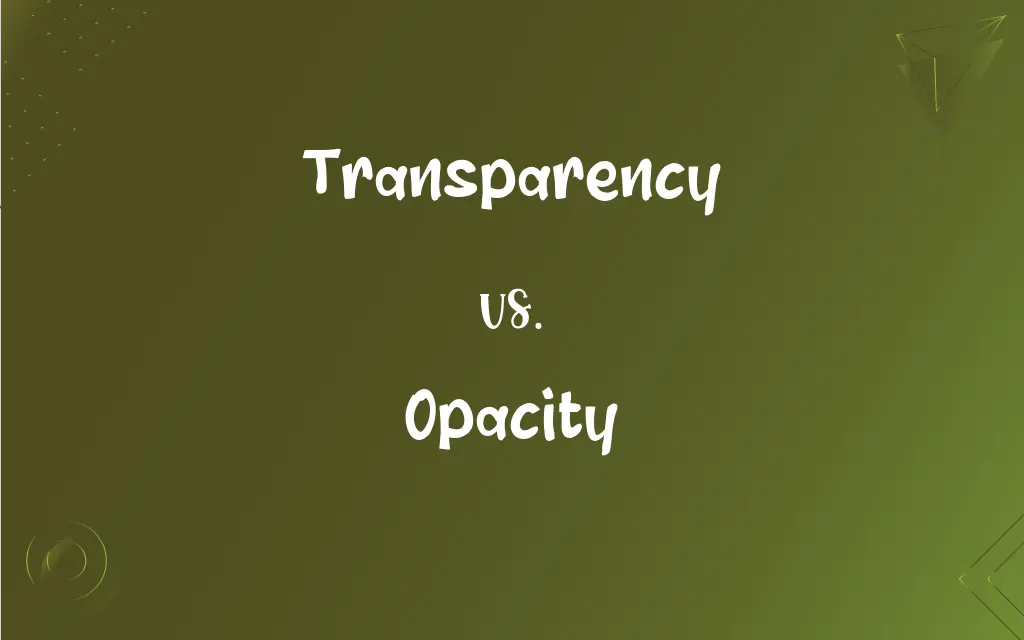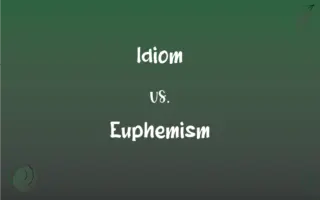Transparency vs. Opacity: What's the Difference?
Edited by Janet White || By Harlon Moss || Updated on November 6, 2023
Transparency is the property of allowing light to pass through so that objects behind can be distinctly seen, whereas opacity is the measure of impenetrability to light of a substance.

Key Differences
Transparency refers to the quality of being see-through, allowing light to pass through clearly, thus enabling us to see through a material. Opacity is the quality of being opaque, meaning it blocks light from passing through, preventing clear view of what lies beyond. Transparency is associated with clarity and openness, while opacity suggests concealment and obstruction.
In the context of materials, transparency allows for the transmission of light to a degree that objects on the other side are visible, as with clear glass. Opacity, however, denotes a material like a metal that doesn't allow any light to pass through, rendering the material completely non-transparent. Transparency and opacity are therefore at opposite ends of the spectrum concerning light transmission.
These terms also extend metaphorically beyond the physical properties of materials. Transparency can refer to openness and accountability, particularly in institutions or governance, where actions and motives are clear. Opacity, in a metaphorical sense, can refer to deliberate obscurity or lack of transparency in processes or communications, often leading to distrust or confusion.
In the digital world, such as in graphic design and photography, transparency refers to the degree to which an image is transparent, allowing background images to show through. Opacity in this context is used to describe the extent to which an image is not transparent, often represented as a percentage in graphics software, with 0% being fully transparent and 100% being fully opaque.
Transparency and opacity also apply to business and information. A transparent organization would have practices that are open to examination by the public or shareholders, promoting trust. An organization described as having opacity might be one that is closed off, with processes that are hidden from stakeholders, which can raise suspicion about its operations.
ADVERTISEMENT
Comparison Chart
Definition
Allows light to pass through clearly.
Blocks light from passing through.
Physical Property
Clear and see-through.
Non-transparent and light-blocking.
Metaphorical Use
Openness and clarity in information or processes.
Concealment or lack of clarity.
Digital Media
Degree to which an image can show background through it.
Degree to which an image blocks the background.
Business and Information
Practices and processes are open to examination.
Practices and processes are hidden or not disclosed.
ADVERTISEMENT
Transparency and Opacity Definitions
Transparency
Openness and accountability in actions and decisions.
The company's transparency helped build trust with its customers.
Opacity
The quality of being opaque and not allowing light to pass through.
The opacity of the curtains blocked out the morning light.
Transparency
The characteristic of being easily seen through.
The transparency of the lake's water revealed the vibrant ecosystem below.
Opacity
The characteristic of being impenetrable by light.
The paint's high opacity was perfect for covering the graffiti on the wall.
Transparency
The condition of being transparent.
The transparency of the window glass was so clear it looked invisible.
Opacity
The degree to which something is difficult to understand.
The opacity of the legal text made it hard for laypeople to understand.
Transparency
The attribute of being open to new ideas and not secretive.
The new policy was developed with a level of transparency that encouraged feedback.
Opacity
In digital images, the condition of being non-transparent.
She set the layer's opacity to 75% to allow some of the color to show through.
Transparency
In graphics, the quality of an image that allows the background to show through.
He adjusted the transparency of the overlay to blend with the image beneath.
Opacity
The state of being hard to see through or comprehend.
The report's opacity left many investors feeling uncertain.
Transparency
Also trans·par·ence (-pârəns, -păr-) The quality or state of being transparent.
Opacity
The quality or state of being opaque.
Transparency
A transparent object, especially a photographic slide that is viewed by light shining through it from behind or by projection.
Opacity
Something opaque.
FAQs
Can transparency be used to describe an organization?
Yes, it can refer to openness in the organization's practices.
Is opacity desirable in a photograph?
It depends on the effect desired; high opacity can enhance or obscure certain elements.
Can a business practice have both transparency and opacity?
Yes, some aspects can be transparent while others remain opaque.
What does 100% transparency mean in a material?
It means the material is completely clear and allows light to pass through without obstruction.
What is meant by 0% opacity?
It means the material or image is fully transparent.
How does transparency affect accountability?
Greater transparency usually leads to higher accountability as actions are more visible.
Does opacity always refer to physical objects?
No, it can also describe the clarity of information or communication.
Does a higher opacity mean less transparency?
Yes, as opacity increases, transparency decreases.
How does transparency impact trust?
Transparency tends to increase trust by making information accessible and understandable.
Are transparent policies always clear?
Policies intended to be transparent should be clear, but they may still be complex.
Can transparency be quantified?
Yes, in some fields like digital graphics, transparency is quantified as a percentage.
Can a window have variable transparency?
Yes, with treatments like frosting or tints, the transparency of a window can vary.
Is a transparent government always better?
Generally, transparency is seen as positive in governance, but there may be exceptions for security or privacy.
Can opacity be partial in a material?
Yes, materials can be semi-opaque, allowing some light through.
What is the opposite of opacity?
The opposite of opacity is transparency.
Is opacity related to color density?
Yes, in paints and inks, higher opacity is often due to greater pigment density.
Is opacity a measure of quality?
Not necessarily, it is a measure of how much light passes through a substance.
Are transparent objects always invisible?
No, they can be visible due to reflections or the edges of the material.
Does opacity imply something negative?
In terms of clarity and openness, yes, but it can be neutral or positive depending on context (e.g., privacy screens).
Can opacity be a visual effect in design?
Yes, designers often adjust opacity for visual impact and layering effects.
About Author
Written by
Harlon MossHarlon is a seasoned quality moderator and accomplished content writer for Difference Wiki. An alumnus of the prestigious University of California, he earned his degree in Computer Science. Leveraging his academic background, Harlon brings a meticulous and informed perspective to his work, ensuring content accuracy and excellence.
Edited by
Janet WhiteJanet White has been an esteemed writer and blogger for Difference Wiki. Holding a Master's degree in Science and Medical Journalism from the prestigious Boston University, she has consistently demonstrated her expertise and passion for her field. When she's not immersed in her work, Janet relishes her time exercising, delving into a good book, and cherishing moments with friends and family.
































































